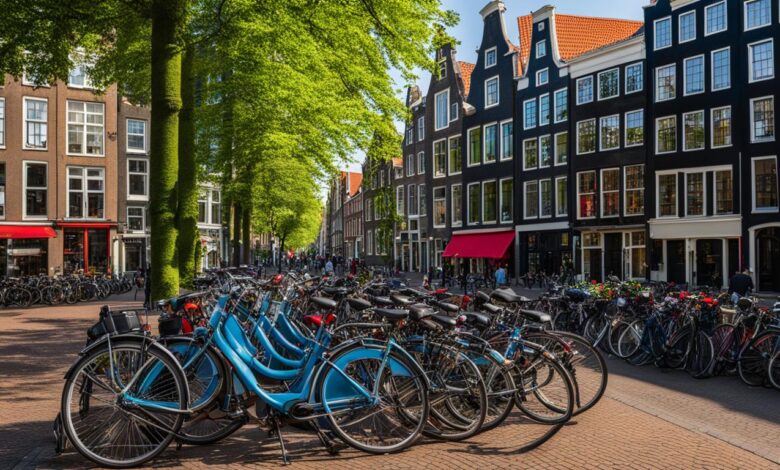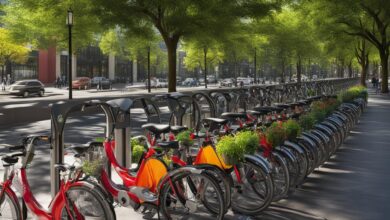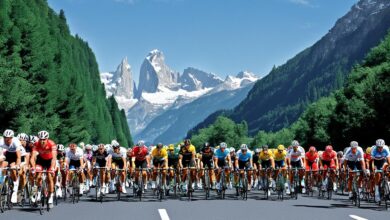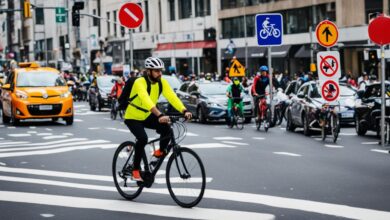Exploring Cycling Traditions in the Netherlands

The Netherlands is renowned for its strong cycling culture and long-standing cycling traditions. With more bikes than citizens, cycling has become deeply ingrained in Dutch daily life and is an integral part of the country’s cultural heritage. From historic customs to modern rituals, the Netherlands offers a fascinating glimpse into a nation where cycling is not just a mode of transportation but a way of life.
Key Takeaways:
- The Netherlands has a rich cycling culture and heritage
- Cycling is deeply integrated into Dutch daily life and customs
- The Dutch government has prioritized cycling infrastructure and safety
- Exploring the Netherlands by bike offers a unique and immersive experience
- Cycling in the Netherlands promotes sustainable transportation and a healthy lifestyle
The Birth of a Cycling Nation
In the 1970s, the Netherlands faced significant challenges with congestion and road safety due to a surge in car ownership. The country experienced a high number of vehicular accidents, including alarming fatality rates among children. It was during this time that the Stop de Kindermoord movement emerged, advocating for safer roads and prioritizing the well-being of the younger generation. The oil crisis of 1973 further intensified the need for alternative modes of transportation.
“The emergence of the Stop de Kindermoord movement and the oil crisis of 1973 prompted the Dutch government to rethink urban planning and prioritize cycling as a viable and sustainable mode of transportation.”
This pivotal moment marked a turning point for the Netherlands, leading to a fundamental shift in urban planning. The Dutch government recognized the potential of cycling and began implementing bike-centric policies and infrastructure to encourage its adoption as a preferred mode of transportation.
These developments formed the foundation of Dutch cycling culture, with a deep-rooted respect for cycling traditions and a commitment to preserving the country’s cycling heritage. Today, the Netherlands stands as a true cycling nation, embracing cycling customs and demonstrating the potential for other countries to follow suit.
Bike-Centric Planning: Cars are Guests
One of the key initiatives undertaken by the Dutch government to promote cycling and prioritize cyclist safety is the creation of an extensive network of bike lanes. Today, the bike lane network spans over 35,000 km, facilitating smooth and efficient cycling throughout the Netherlands. This network serves as a testament to the country’s commitment to creating a bike-centric infrastructure and fostering a culture that encourages cycling as a primary mode of transportation.
But it doesn’t stop there. The Dutch have gone a step further by implementing an innovative approach to road design that prioritizes bicycles over cars. Certain roads in the Netherlands proudly display signs stating that “cars are guests,” further emphasizing the importance of cycling in Dutch culture and transportation planning.
Dutch roundabouts, in particular, exemplify the country’s commitment to accommodating and prioritizing cyclists. These roundabouts feature dedicated cycle tracks that encircle the roundabout, providing a safe and efficient passage for cyclists. By segregating cyclists from motor vehicles, Dutch roundabouts effectively reduce potential conflicts, enhancing the overall safety and comfort of cyclists navigating these junctions.
To illustrate the magnitude of this bike-centric design, consider the following table, which compares the number of Dutch roundabouts and the length of Dutch bike lanes:
| Number of Dutch Roundabouts | Length of Dutch Bike Lanes (in Kilometers) |
|---|---|
| 1,513 | 35,000+ |
This table clearly demonstrates the Dutch government’s commitment to providing cyclists with safe and convenient infrastructure. With over 1,500 roundabouts designed specifically to accommodate cyclists and an extensive network of bike lanes, it’s no wonder that the Netherlands is renowned as a cycling paradise.
Cycling habits in the Netherlands reflect the success of these bike-centric initiatives. People of all ages and backgrounds embrace cycling as a way of life, contributing to the country’s vibrant cycling culture. Whether it’s commuting to work or running errands, the Dutch value the convenience and health benefits of cycling, fueling their commitment to prioritize and invest in cycling infrastructure.
As the Dutch government continues to expand and improve its bike-centric planning, it serves as an inspiration to countries around the world. By prioritizing cyclists, investing in bike infrastructure, and fostering a cycling-friendly culture, the Netherlands has revolutionized the way cities rethink urban mobility. With its impressive network of bike lanes and cyclist-oriented roundabouts, the Netherlands stands as a model of sustainable transportation and the epitome of a true cycling nation.
Investing in Cycling Infrastructure
The Netherlands is committed to creating a cycling-friendly environment through substantial investments in cycling infrastructure. This dedication is evident in the development of extensive bike parking facilities across the country. Notably, the city of Utrecht is home to the world’s largest multistorey bike park, capable of accommodating up to 12,500 bikes at a time.
Train stations in the Netherlands also prioritize cycling convenience by providing bike parking facilities for commuters. Some train services even offer dedicated spaces specifically designed for bicycles, making it seamless for travelers to transition between different modes of transport.
Benefits of Dutch Bike Parking Facilities
The availability of ample bike parking facilities in the Netherlands yields several benefits:
- Enhanced Security: Dutch bike parking facilities are designed to ensure the safety and security of bicycles, reducing the risk of theft or damage.
- Promotion of Cycling Culture: By providing convenient and secure parking options, the Dutch government encourages more people to choose cycling as their preferred mode of transportation.
- Reduced Congestion: Ample bike parking spaces alleviate the strain on other transportation systems, reducing traffic congestion and improving overall transportation efficiency.
- Sustainable Urban Development: Investing in bike parking facilities aligns with the Netherlands’ commitment to sustainable urban development, promoting a healthier and greener way of commuting.
The Role of Bike Parking in Dutch Cycling Culture
“Dutch bike parking facilities are a testament to the country’s cycling culture. They reflect the recognition of bicycles as a vital and valued mode of transportation in the Netherlands.”
By prioritizing the development of bike parking infrastructure, the Netherlands embraces cycling as not only a mode of transport but a way of life. The presence of well-planned and accessible bike parking facilities allows cyclists to seamlessly integrate cycling into their daily routines, whether it’s for commuting, running errands, or leisurely rides. Dutch bike parking facilities are a foundation for fostering a vibrant and sustainable cycling culture.
| Benefits of Dutch Bike Parking Facilities | Summary |
|---|---|
| Enhanced Security | Bike parking facilities prioritize safety and reduce the risk of theft or damage. |
| Promotion of Cycling Culture | Convenient and secure parking options encourage more people to choose cycling as a mode of transportation. |
| Reduced Congestion | Ample bike parking spaces help alleviate traffic congestion and improve overall transportation efficiency. |
| Sustainable Urban Development | Bike parking facilities contribute to the Netherlands’ commitment to sustainable urban development. |
Benefits of Being a Cycling Nation
The Netherlands’ commitment to cycling has yielded numerous benefits. Studies have shown that cycling has positive effects on individual health, productivity, and societal well-being. Dutch cycling contributes significantly to the economy, with bike-related industries supporting thousands of jobs. The social export value of Dutch cycling is estimated to be worth billions of euros annually. The Dutch government continues to prioritize and promote cycling, aiming to increase the number of people commuting by bike and enhance accessibility for all.
There are several key benefits of being a cycling nation:
- Cycling promotes physical and mental well-being: Regular cycling helps improve cardiovascular health, strengthens muscles, and reduces the risk of chronic diseases. It also has positive impacts on mental health by reducing stress and anxiety levels.
- Cycling boosts productivity: Studies have shown that individuals who cycle to work are more productive and focused. Cycling improves cognitive function, creativity, and problem-solving skills.
- Cycling reduces traffic congestion and pollution: By choosing cycling over cars, the Netherlands has effectively reduced traffic congestion and carbon emissions. This contributes to a cleaner and more sustainable environment.
- Cycling promotes social interaction: The Dutch cycling culture fosters a sense of community and social interaction. Cyclists often gather at cafes, parks, and other public spaces, creating opportunities for connections and friendships.
- Cycling supports the economy: The thriving bike-related industries in the Netherlands, including manufacturing, retail, and tourism, generate significant economic value. These industries create jobs and contribute to local and national economic growth.
“Cycling in the Netherlands is not just a means of transportation; it is a way of life.”
The Dutch government recognizes the manifold benefits of cycling and continues to invest in cycling infrastructure, education, and promotion. They aim to further integrate cycling into everyday life and encourage more people to adopt cycling as a preferred mode of transportation.
| Benefits of Being a Cycling Nation in the Netherlands | Overview |
|---|---|
| Improved Individual Health | Cycling promotes cardiovascular health, strength, and mental well-being. |
| Increased Productivity | Cycling enhances cognitive function, problem-solving skills, and creativity. |
| Reduced Traffic Congestion and Pollution | Cycling reduces traffic congestion and carbon emissions, creating a cleaner environment. |
| Enhanced Social Interaction | The cycling culture in the Netherlands fosters a sense of community and connectivity. |
| Economic Growth | Bike-related industries contribute to the economy, generating jobs and revenue. |
The benefits of being a cycling nation extend beyond individual health and contribute to a more sustainable, inclusive, and prosperous society.
Exploring the Netherlands by Bicycle: Top Cycling Routes
The Netherlands offers a plethora of diverse and scenic cycling routes that allow you to immerse yourself in the country’s natural beauty and rich cultural heritage. Whether you prefer picturesque landscapes, charming towns, or iconic landmarks, there is a route to cater to every preference. Here are some notable cycling routes that showcase the best of what the Netherlands has to offer:
- Sand dunes of Zandvoort: Explore the stunning sand dunes along the coast of Zandvoort. This route offers breathtaking views of the North Sea and the vibrant surrounding nature.
- River Vecht to Utrecht: Cycle alongside the scenic River Vecht as you make your way to the beautiful city of Utrecht. Admire the historic mansions and picturesque landscapes along the way.
- Polders of Waterland: Experience the unique Dutch landscape as you ride through the charming polders of Waterland. Enjoy the sight of meandering waterways, traditional wooden houses, and vast open fields.
- Windmills at Kinderdijk: Take a journey through time as you cycle past the iconic windmills at Kinderdijk. These well-preserved windmills are a testament to the Netherlands’ rich history and engineering prowess.
- Tulip fields of Noordoostpolder: Indulge in the beauty of vibrant tulip fields as you pedal through the picturesque landscape of Noordoostpolder. This route offers a breathtaking display of colors during the blooming season.
These cycling routes not only provide an opportunity to explore the stunning natural surroundings of the Netherlands but also allow you to delve into the country’s rich history, culture, and traditions.

A Comparison of Cycling Routes in the Netherlands
| Route | Distance | Difficulty | Highlights |
|---|---|---|---|
| Sand dunes of Zandvoort | 20 km | Easy | Beautiful coastal views, pristine sandy beaches |
| River Vecht to Utrecht | 30 km | Moderate | Historic mansions, scenic river views, Utrecht city center |
| Polders of Waterland | 25 km | Easy | Traditional wooden houses, meandering waterways, open fields |
| Windmills at Kinderdijk | 40 km | Moderate | Iconic windmills, UNESCO World Heritage site |
| Tulip fields of Noordoostpolder | 35 km | Moderate | Vibrant tulip fields, picturesque landscapes |
Cycling Tips for Exploring the Netherlands
When planning a cycling trip in the Netherlands, it is advisable to take certain factors into consideration. Here are some helpful tips to ensure a smooth and enjoyable experience:
- Consider taking bikes on trains: Taking your bikes on trains is a convenient way to explore different regions of the Netherlands. Tickets allowing bike transportation can be purchased, making it easier to access various cycling routes.
- Book accommodations in advance: To make the most of your cycling trip, it is recommended to book accommodations in advance. Options such as bed and breakfasts (B&Bs) are popular among cyclists, offering cozy and welcoming places to stay along your route.
- Obtain bicycle insurance: It is prudent to obtain bicycle insurance to ensure protection against accidents and theft. This will provide peace of mind during your cycling adventure in the Netherlands.
By considering these tips, you can make the most of your cycling trip in the Netherlands and fully immerse yourself in the Dutch cycling culture.
The Dutch Cycling Experience
Cycling in the Netherlands offers a unique experience shaped by the country’s cycling culture and infrastructure. The Dutch have a deep-rooted cycling tradition and prioritize cycling as a sustainable and efficient mode of transportation.
With well-organized cycling paths, low traffic-related risks, and a flat terrain, cycling in the Netherlands is accessible and enjoyable for all ages and experience levels.
The country’s beautiful landscapes, rich culture, and friendly atmosphere make cycling an immersive way to explore and connect with the Dutch way of life. Whether you’re cycling through picturesque countryside, charming towns, or vibrant cities, you’ll get a true sense of the Dutch cycling customs and habits that have shaped the nation.
The Dutch cycling culture encourages a sense of community and environmental consciousness. It’s common to see people of all backgrounds, from young children to seniors, commuting, running errands, or simply enjoying leisurely rides.
“Cycling in the Netherlands is not just about transportation; it’s a way of life. It’s about being part of a community and enjoying the freedom and simplicity that cycling brings.”
The Dutch cycling infrastructure, with its extensive network of bike lanes and cyclist-friendly traffic policies, ensures a safe and convenient cycling experience. The well-maintained paths are clearly marked and integrated into the overall transportation system, making it easy to navigate through cities and explore the countryside.
Whether you’re a seasoned cyclist or a beginner, the Netherlands offers a range of cycling routes suited to different preferences and interests. From coastal rides to tulip fields, historic windmills to modern architecture, there’s something for everyone.
Discover the Dutch cycling experience and explore the country at your own pace, immersing yourself in the cycling customs, habits, and traditions that are deeply ingrained in Dutch culture.
Benefits of Cycling in the Netherlands
- Improve your health: Cycling regularly contributes to physical fitness, cardiovascular health, and mental well-being.
- Environmental sustainability: By choosing to cycle instead of drive, you actively contribute to reducing carbon emissions and promoting a greener future.
- Ease of navigation: With well-defined bike lanes and a comprehensive network of cycling routes, it’s easy to navigate through the Netherlands.
- Cost-effective: Cycling is an affordable mode of transportation, saving you money on fuel, parking fees, and public transportation costs.
- Discover hidden gems: Cycling allows you to explore off-the-beaten-path destinations and experience the beauty of the Netherlands up close.
Climate and Cycling in the Netherlands
The Netherlands boasts a mild maritime climate that lends itself favorably to cycling. With mild temperatures and relatively low rainfall, cyclists can enjoy a pleasant riding experience throughout the year. However, it is wise to come prepared with rainwear or an umbrella, particularly during the wetter seasons.
When planning a cycling excursion in the Netherlands, it is essential to consider the ideal time for riding. Spring to early autumn, specifically from May to September, typically offers the most optimal weather conditions for cyclists. During these months, the temperatures are mild, the days are longer, and the chances of encountering heavy rainfall are relatively low.
Climate Data for Cycling in the Netherlands
| Season | Average Temperature (°C) | Average Rainfall (mm) |
|---|---|---|
| Spring (March – May) | 10 – 15 | 40 – 50 |
| Summer (June – August) | 20 – 25 | 60 – 70 |
| Autumn (September – November) | 10 – 15 | 60 – 70 |
| Winter (December – February) | 0 – 5 | 50 – 60 |
While the temperature ranges vary throughout the year, it is generally mild, but it is advisable to pack appropriate clothing layers to accommodate any temperature fluctuations during rides. Being aware of the climate conditions and planning accordingly will ensure an enjoyable and comfortable cycling experience in the Netherlands.
Unique Aspects of Dutch Bicycles
Dutch bicycles have gained recognition worldwide for their distinctive features and versatility. They embody the essence of Dutch cycling culture, reflecting the practicality and adaptability valued by cyclists in the Netherlands.
“Dutch bicycles are a testament to the country’s commitment to sustainable transportation and functional design. They offer unique solutions for various needs and preferences, making them a perfect fit for the diverse cycling habits in the Netherlands,” says Janine van de Water, a cycling enthusiast based in Amsterdam.
One notable type of Dutch bicycle is the beer bike. This unique design allows cyclists to enjoy a drink while pedaling, making it a popular choice for social gatherings and celebrations.
The oma-fiets (grandma bike) and mamafiets (mom bike) are iconic Dutch bicycles known for their classic, retro style. These bicycles are designed with a comfortable and upright riding position, making them ideal for leisurely rides and everyday commuting.
The bakfiets (cargo bike) is another distinctive Dutch bicycle that has gained popularity not only in the Netherlands but also around the world. With its spacious front cargo area, the bakfiets offers a convenient and eco-friendly alternative for transporting groceries, children, or even pets.
Dutch cyclists also enjoy riding tandems, which are bicycles built for two or more riders. Tandems allow couples, friends, or family members to experience the joy of cycling together, fostering a sense of togetherness and shared adventure.
These unique bicycle designs embody the essence of Dutch cycling culture, showcasing the Dutch people’s commitment to practicality, sustainability, and enjoyment of the cycling experience.
Conclusion
The Netherlands is renowned for its cycling traditions, which have become an integral part of the country’s culture and identity. The Dutch have embraced cycling as a sustainable mode of transportation, evident in their extensive network of bike lanes and bike-friendly infrastructure. With a commitment to safety and accessibility, cycling has become a way of life for millions of people in the Netherlands.
Exploring the Netherlands by bike offers a unique perspective on Dutch culture and heritage. From picturesque landscapes to charming towns, cyclists can immerse themselves in the country’s natural beauty and rich history. The Netherlands’ long-standing dedication to sustainable transportation is on full display, making it a paradise for cyclists from around the world.
For an unforgettable experience, cyclists and cultural enthusiasts alike should discover the cycling traditions in the Netherlands. The country’s diverse cycling routes cater to all preferences, showcasing stunning natural surroundings and reflecting the Dutch commitment to sustainable transportation. Whether it’s admiring windmills, exploring tulip fields, or navigating the iconic Dutch bike lanes, the Netherlands offers a truly memorable journey through its cycling traditions.
FAQ
What led to the rise of cycling in the Netherlands?
The surge in car ownership, coupled with concerns about road safety, congestion, and the oil crisis of 1973, prompted the Dutch government to prioritize cycling and shift towards bike-centric urban planning.
How has the Dutch government invested in cycling infrastructure?
The Dutch government has created an extensive network of bike lanes spanning over 35,000 km, redesigned junctions and roundabouts to prioritize cyclist safety, and developed large bike parking facilities across the country.
What are the benefits of cycling in the Netherlands?
Studies have shown that cycling in the Netherlands has positive effects on individual health, productivity, and societal well-being. It also contributes significantly to the economy, supporting thousands of jobs and generating billions of euros annually.
What are some popular cycling routes in the Netherlands?
Some notable cycling routes in the Netherlands include the sand dunes of Zandvoort, the River Vecht to Utrecht, the polders of Waterland, the windmills at Kinderdijk, and the tulip fields of Noordoostpolder.
What tips should I keep in mind when cycling in the Netherlands?
It is recommended to take bikes on trains for regional exploration, book accommodations in advance (such as bed and breakfasts), and obtain bicycle insurance for protection against accidents and theft.
What makes cycling in the Netherlands unique?
The Netherlands has an extensive cycling culture and infrastructure, with well-organized cycling paths, low traffic-related risks, and a flat terrain. It offers a unique perspective on Dutch culture, opportunities to explore stunning natural surroundings, and showcases the country’s commitment to sustainable transportation.
What is the climate like for cycling in the Netherlands?
The Netherlands has a mild maritime climate, with mild temperatures and relatively low rainfall. Spring to early autumn, from May to September, is typically the ideal time for cycling in the country.
What are some unique aspects of Dutch bicycles?
Dutch bicycles are known for their distinctive designs and versatility, including bikes such as the beer bike, oma-fiets (grandma bike), mamafiets (mom bike), bakfiets (cargo bike), and tandem. These bikes cater to various needs and preferences.
How has the Netherlands become a cycling nation?
The Netherlands has a rich cycling heritage and has made significant investments in cycling infrastructure and culture. With its bike-centric planning, extensive network of bike lanes, and emphasis on safety, cycling has become deeply ingrained in Dutch daily life and identity.




